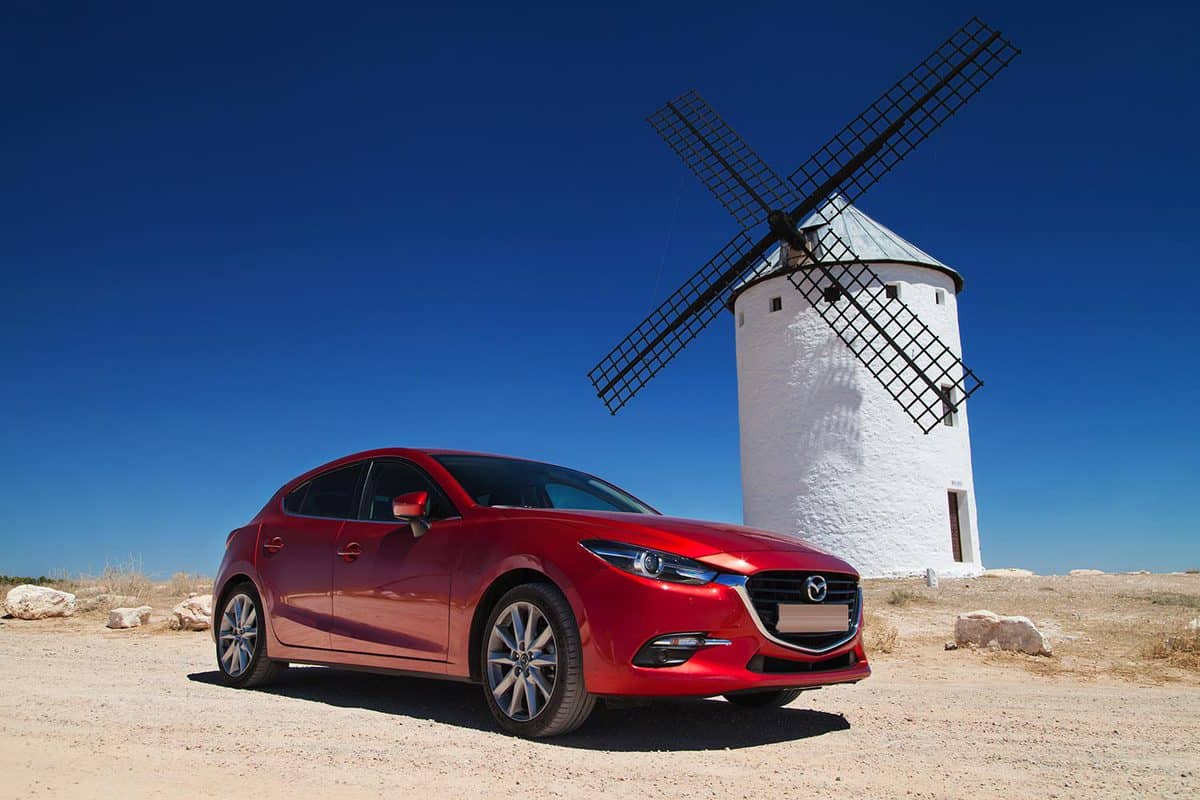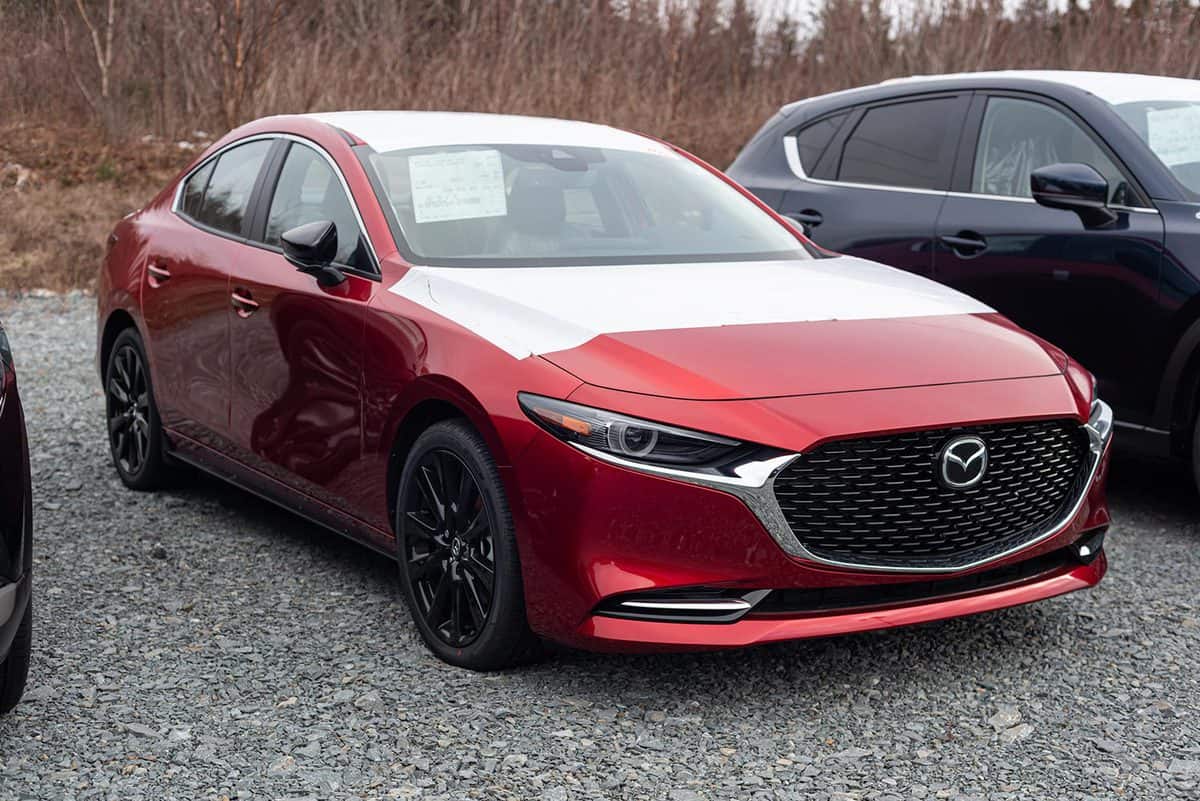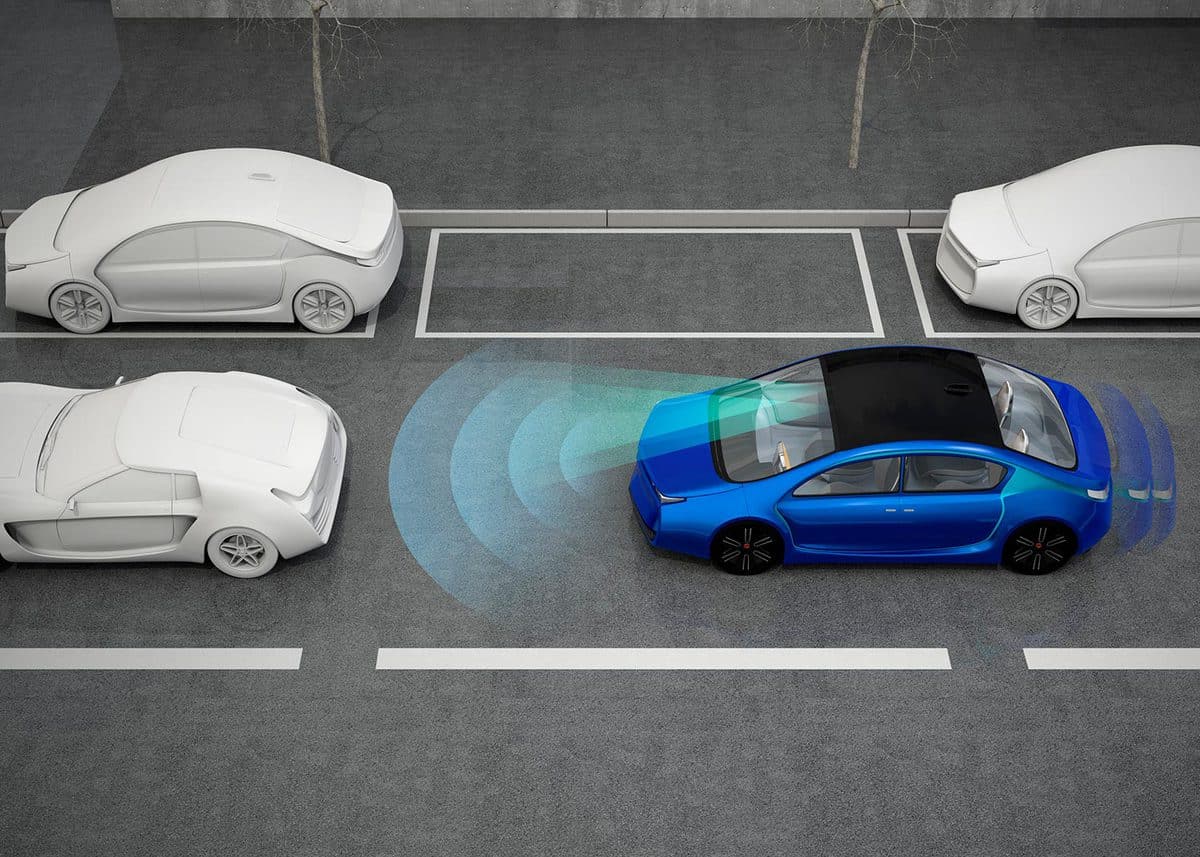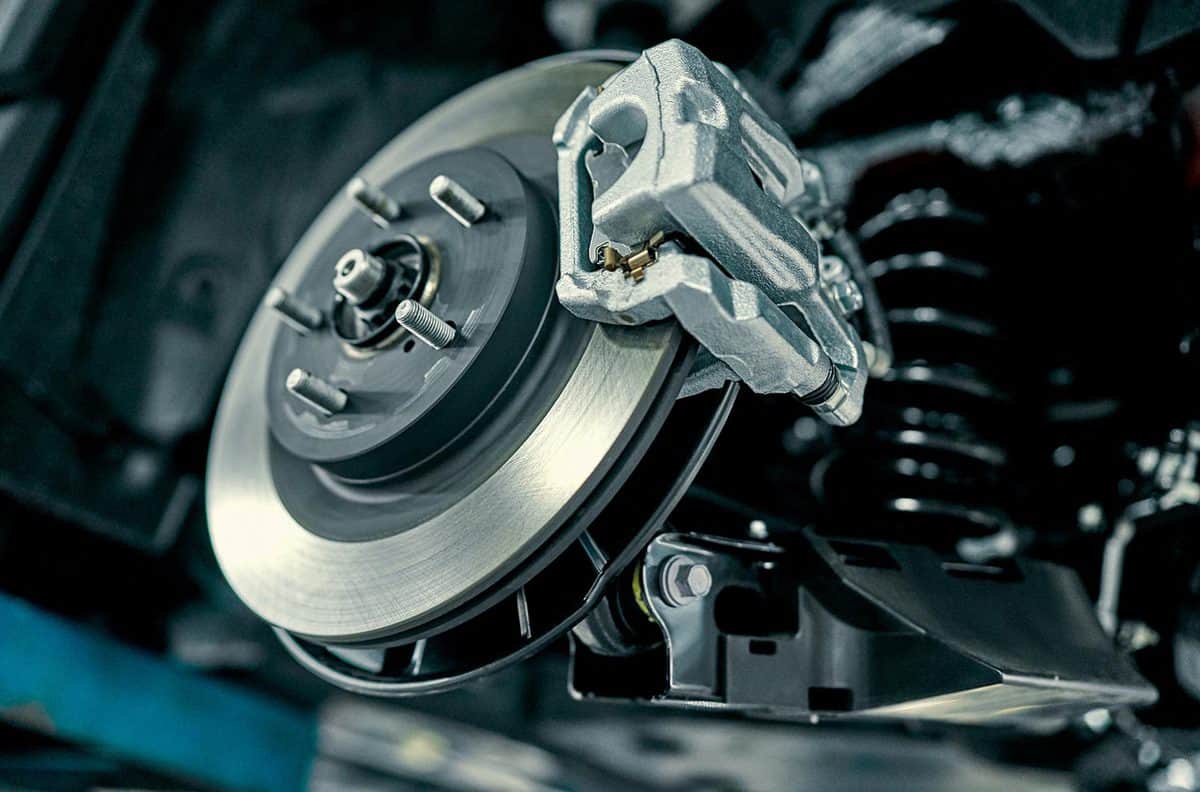Are you considering buying a car that would be great for driving in winter? Or perhaps you have a Mazda 3 and were wondering if it came in AWD? Wonder no more, for we have the answer right here for you.
Starting with the launch of its fourth-generation Mazda 3 line-up in 2019, buyers can choose between an FWD and an AWD drivetrain in some trims.
Although Mazda started to offer AWD for Mazda 3 in 2019, it was not available for all trims of its two model versions—the sedan and the hatchback. We broke down the different models and trims that offered AWD to make it easy for you to know which model has AWD. Moreover, we will talk about other Mazda 3 information that you could find useful. Read on!
![Mazda3 Sedan on the road with a beautiful mountain on the back, Does Mazda 3 Have AWD? [By Year And Trim Level]](https://vehq.com/wp-content/uploads/2022/02/Does-Mazda-3-Have-AWD-By-Year-And-Trim-Level-683x1024.png)
Does Mazda 3 have AWD?
The development of tires for winter use in the 60s sparked the interest to give the benefits of AWD to conventional passenger cars. These cars were not designed for off-road driving but for driving in snow or on wet roads.
Mazda developed a predictive AWD technology dubbed the i-ACTIV AWD. This i-ACTIV is an AWD system that helps make the Mazda 3 easy to control on snowy roads.
Traditional AWD systems only monitor the relative wheel speed. The i-ACTIV AWD system monitors 27 different variables at a rate of more than 200 times per second. This allows the i-ACTIV system to make adjustments on the fly, like torque adjustments and transferring power to the rear wheels before the front wheels slip.
2019 introduction of AWD
When Mazda introduced Mazda 3 Sedan Select, Mazda 3 Sedan Preferred, and Mazda 3 Sedan Premium in 2019, consumers were given the option to install the regular FWD or the AWD drivetrain.
The Mazda 3 Hatchback introduced the Mazda 3 Hatchback Preferred, Mazda 3 Hatchback Premium, and the Mazda 3 Hatchback Standard with the option to install an AWD drivetrain or the regular FWD.

Three of the four new trims of the Mazda 3 Sedan offered AWD. On the other hand, even though Mazda 3 Hatchback only introduced three new trims for their fourth-generation line-up, all trims offered AWD drivetrains.
2021 Mazda 3 Models

Mazda discontinued the Mazda 3 Sedan Standard and replaced it with two new trims in 2021; the new trims did not offer the AWD option.
On the other hand, Mazda discontinued the Mazda 3 Hatchback Standard after being in the market for only two years. It was replaced with three new trims bringing the total Mazda 3 Hatchback available trims to five.
The new Mazda 3 Hatchback Select offered the option to install an AWD drivetrain instead of the regular FWD. The Mazda 3 Hatchback 2.5 S did not have the option to have an AWD drivetrain installed.
The Mazda 3 Hatchback 2.5 Turbo was a unique trim across all Mazda 3 trims because it only offered AWD drivetrain. The standard FWD drivetrain cannot be installed on the Mazda 3 Hatchback 2.5 Turbo.
2022 Mazda 3 Models
Two trims were dropped from the Mazda 3 Sedan lineup in 2022—the Mazda 3 Sedan Premium and the Mazda 3 2.0 Sedan. These two were replaced by two new trims that did not offer any AWD options—the Mazda 3 Sedan 2.0 and the Mazda 3 Sedan Carbon Edition.
Additionally, the Mazda 3 Sedan Select stopped offering an AWD option, leaving only the Mazda 3 Sedan Preferred as the only trim that has the option to install an AWD drivetrain instead of the FWD.
On the hatchback side, the Mazda 3 Hatchback 2.5 Turbo was discontinued and was replaced with the Mazda 3 Hatchback Carbon Edition. Unfortunately, this trim did not offer the option to install an AWD drivetrain just like its Mazda 3 Sedan counterpart.
Similar to the change made on the sedan side, the Mazda 3 Hatchback Select stopped offering the option to install an AWD drivetrain. This left only the Mazda 3 Hatchback Preferred and the Mazda 3 Hatchback Premium as the only trims with an AWD option.
Is the Mazda 3 AWD good in snow?
Mazda developed the Ice Academy to test the i-ACTV AWD system. It was hosted in Crested Butte, Colorado.
According to Engine Patrol, the Mazda 3 will serve drivers well in all winter conditions except for the harshest.
Is Mazda 3 a good winter car?
Mazda 3 trims that offer the AWD option are better for winter driving because they provide better traction. Additionally, the turbo engine has more than enough torque to allow the Mazda 3 to power out of deep snow and slippery inclines.
The following additional features make Mazda 3 a good winter car in addition to the optional AWD:
Traction Control
There are sensors on Mazda 3’s wheels that detect individual wheel speeds to help prevent wheel spins. This improves traction on slippery winter roads.
Check out the Super Z6 cable tire chain for passenger cars, pickups, and SUVs from the Security Chain Company. See it on Amazon.
G-Vectoring Control Plus
Also known as the GVC Plus system, it is responsible for adjusting torque to the wheels and applies brakes whenever necessary to improve handling. This system helps make the Mazda 3 safer to drive and provides better handling through corners.
This system is a standard feature in all Mazda 3 models and trims, even in the FWD variants.
Dynamic Stability Control
The DSC (a system based on the ESC) is a secondary safety feature for situations that GVC Plus can no longer handle. The DSC will be engaged if the onboard computer detects a possible skid that GVC Plus will not be able to prevent.
The Dynamic Stability Control manages the brakes and the power delivered to each wheel to prevent unintentional oversteering or understeering.
Smart Brake Support

Mazda 3’s Smart Brake Support or SBS makes use of radar and laser sensors to detect the presence of obstacles in front of the car. It will automatically engage the brakes once it senses a possible collision.
If the driver stepped on the brakes at the right time, the SBS system will still assist in providing additional braking power to stop the Mazda 3 faster.
Slippery roads during winter make it important to have extra braking power to stop in time and avoid a collision.
Electronic Brake Force Distribution
Mazda 3 features an Electronic Brake Force Distribution system or the EBD. It monitors and manages the applied brake force to the front and rear wheels.
Under normal conditions, more brake pressure is applied to the front wheels. The weight of the engine and the driver gives more load to the front wheels of the car. Consequently, this gives the rear wheels less grip and have a higher likelihood of skidding.
The EBD system can detect additional weight on the rear wheels (due to trunk cargo or back seat passengers) and applies additional brake force as needed. The extra braking force helps compensate for the extra weight and improves the braking performance of the Mazda 3, especially on slippery winter roads.
Our article here has tips to winterize your Mazda 3 or any other car.
Does Mazda 3 have a snow mode?
Mazda 3 doesn’t have a snow mode like some Toyota and Lexus models.
However, the combination of G-Vectoring Control and i-ACTIV AWD makes the Mazda 3 a competent winter vehicle. The absence of a snow mode in the Mazda 3 doesn’t hamper its effectiveness on winter roads.
What are the disadvantages of AWD?
Now that we’ve talked about all the benefits that an advanced AWD system provides and the other systems that make it even more effective, it is time to talk about the disadvantages of an AWD vehicle.
Heavier weight
An AWD car has more components, and the AWD drivetrain makes the AWD version hundreds of pounds heavier than its FWD counterpart.
More strain on the brakes

Since an AWD Mazda 3 is heavier, it will need more force to stop compared with an FWD Mazda 3. This creates more strain on the brakes, and they will wear out faster than on an FWD Mazda 3.
Poor fuel economy
Mazda developed their i-ACTIV AWD with fuel economy in mind. However, the fuel economy of an AWD can never match the fuel economy of an FWD.
Heavier cars need more power to accelerate. More power means more fuel will be consumed.
Find out when your car uses more fuel (winter or summer) in this article.
More expensive
Mazda offered the FWD and the AWD drivetrain options on some Mazda 3 trims so that they do not have to burden consumers with a higher price tag in case they don’t really need an AWD.
A Mazda 3 with an AWD drivetrain has more parts and will thus be more expensive to match the cost of manufacturing and installating these additional parts.
More expensive to maintain
More components and parts equal more expensive maintenance costs. There are many parts on an AWD Mazda 3 that are not present in an FWD Mazda 3.
These extra parts will all need maintenance, and the owner will have to pay for them.
Higher tire replacement costs
The tires on an AWD vehicle (not just an AWD Mazda 3) should be uniform.
If the tires on your AWD are mismatched—if they don’t have the same wear—the traction system can get confused. An uneven set of tires can also cause unnecessary wear and tear to other components during driving.
Thus, when you puncture one tire on your AWD Mazda 3, you’ll have to replace all four tires.
The TL Tooluxe 50002L universal heavy-duty tire repair kit is available: See it on Amazon.
Is AWD really necessary?
After all the talk about the advantages and disadvantages, you might be asking yourself if AWD is really necessary.
Whether you need an AWD vehicle or not depends on where you live.
If you live in a place where there can be a lot of snow, mud, or other precipitation, then having an AWD vehicle would be a good idea. On the other hand, if you live where you only do mostly city and highway driving, then having an AWD might not be a good move for you.
Conclusion
The introduction of an optional predictive AWD system in some trims made Mazda 3 a more reliable car for winter. Hopefully, you can now weigh the pros and cons of AWD to select the best Mazda 3 model and trim lelve for your driving style.


